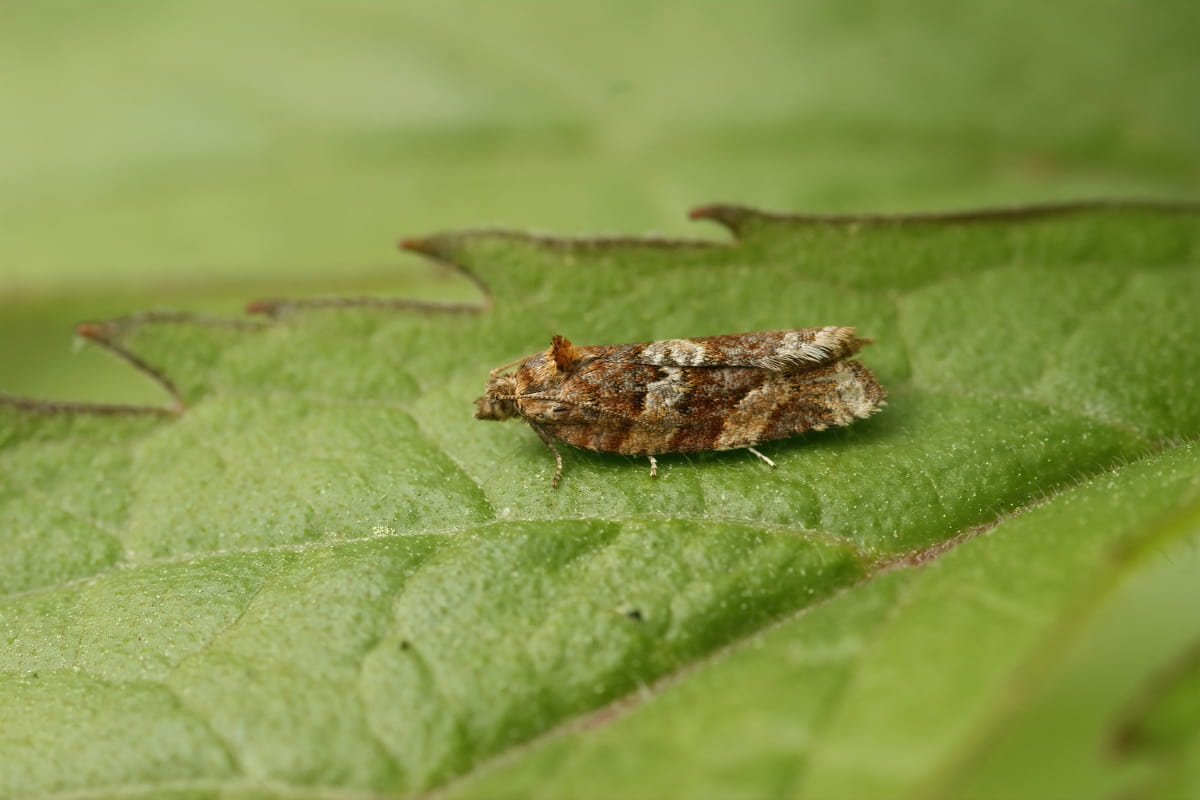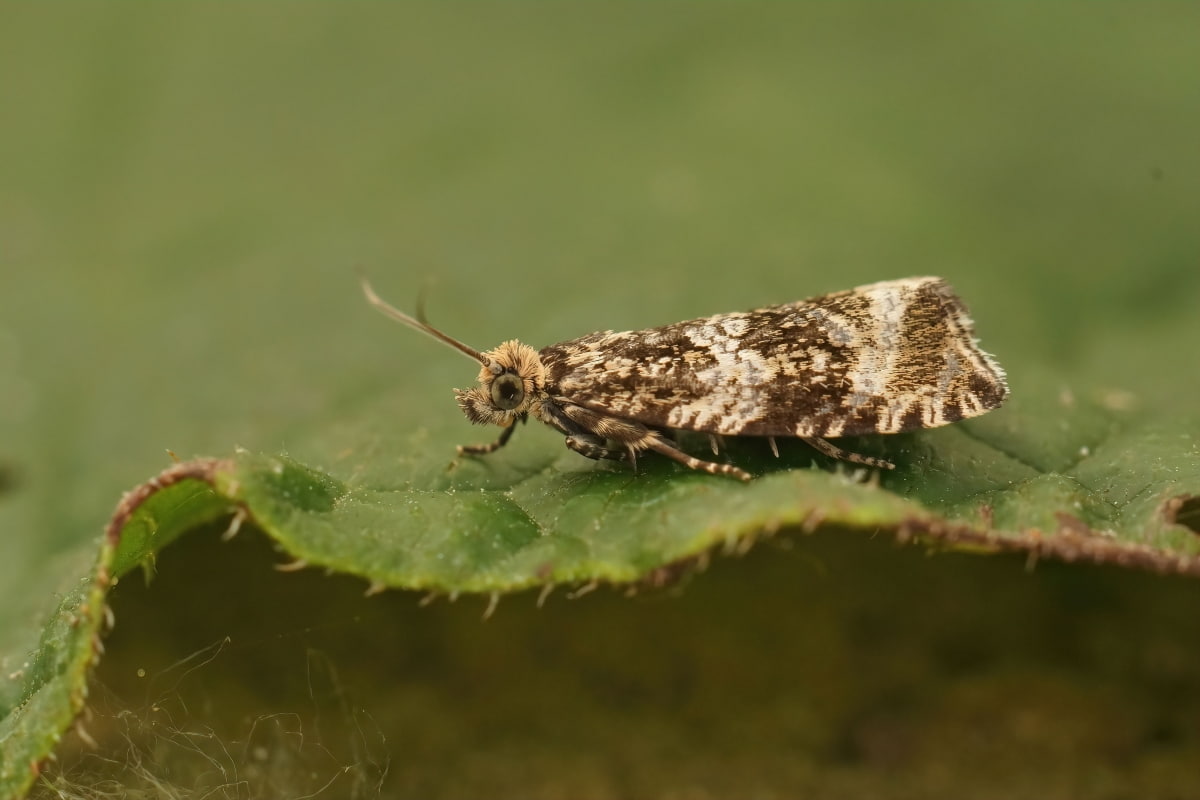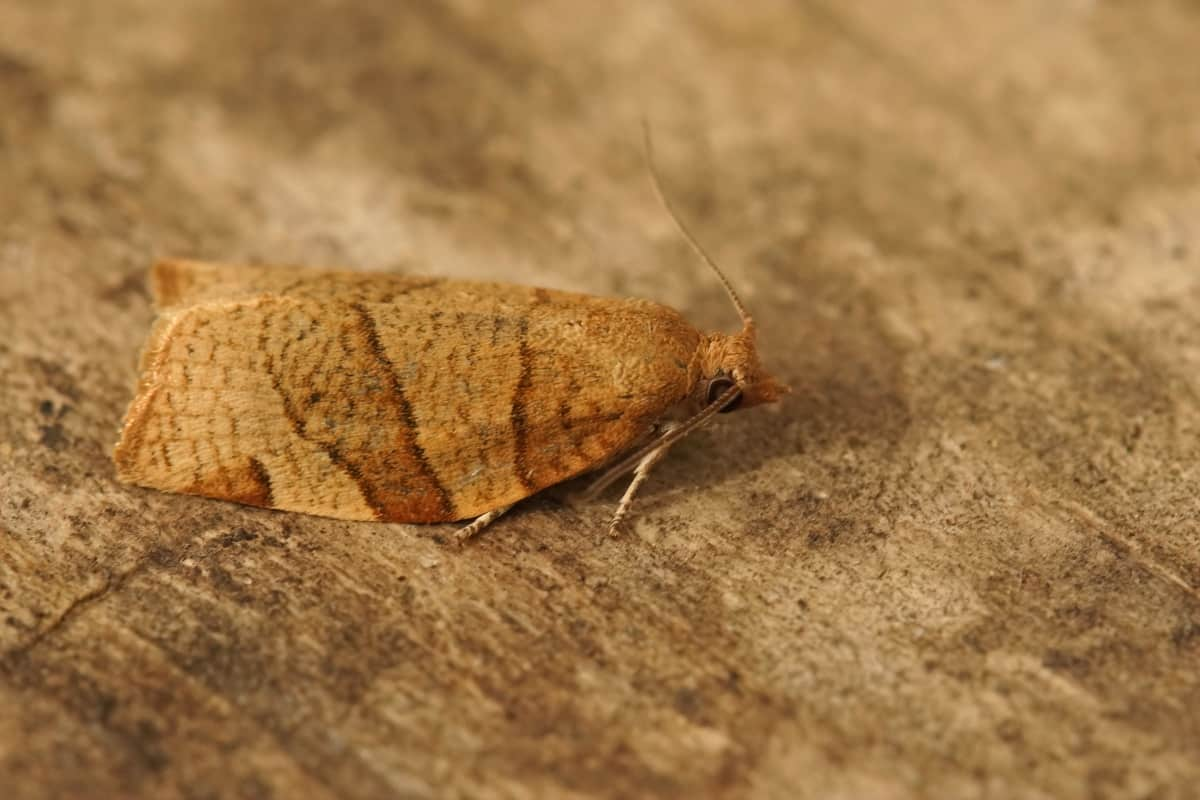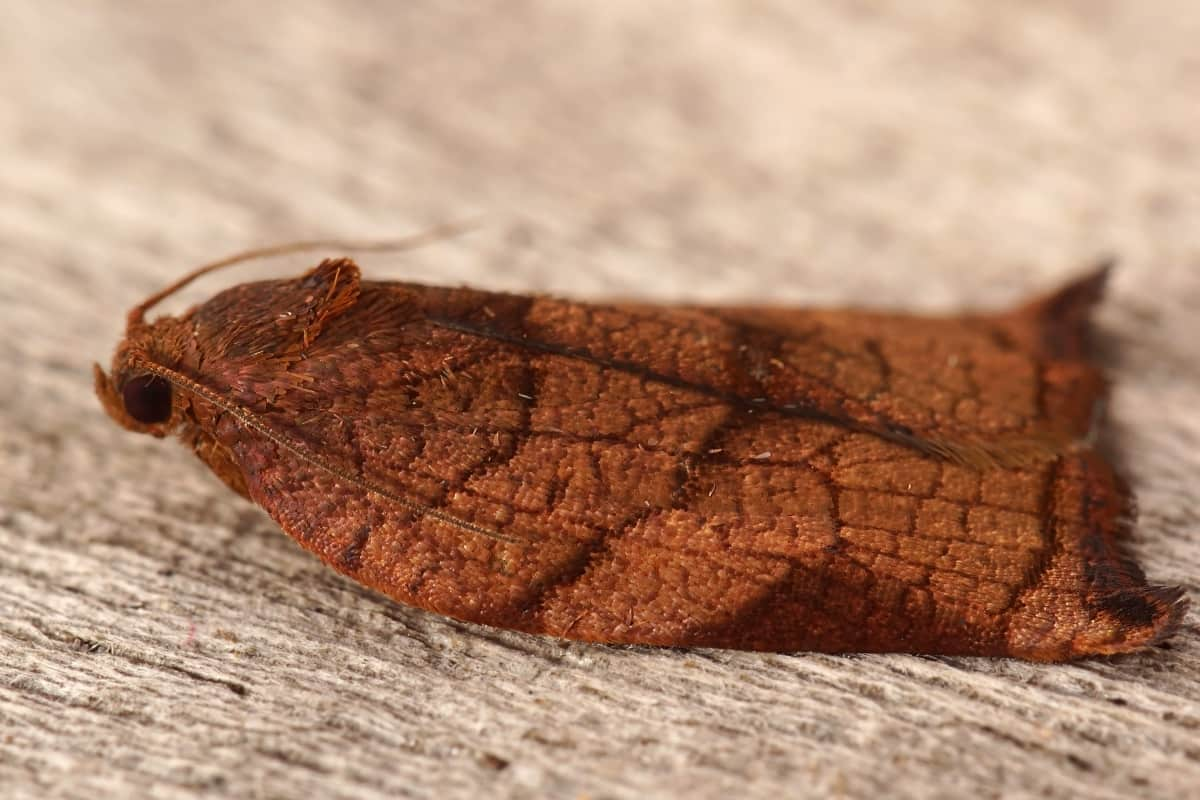Tortrix moths typically lay their eggs on the underside of leaves or in plant crevices. Upon hatching, the larvae feed voraciously on foliage, often rolling themselves in leaves for protection, hence the name “leafroller moths.” After a period of feeding, they pupate and emerge as adult moths. This lifecycle can vary depending on environmental conditions but generally occurs within a few weeks to months.
Identifying Early Signs of Tortrix Moth Damage
Early signs of tortrix moth damage include irregularly shaped holes in leaves, chewed edges, or rolled leaves containing larvae. Leaf curling or binding of leaves with silk threads is also indicative of their presence. Also, inspect the undersides of leaves for eggs or small larvae. Regular monitoring of plants, especially susceptible ones, can help catch infestations early on, facilitating effective management strategies.

How to Control Tortrix Moths
Initial Steps for Effective Control
Quick Identification and Assessment of Infestation Levels
Begin by closely inspecting plants for signs of tortrix moth activity, such as leaf damage, larvae, or eggs. Check both the upper and undersides of leaves, focusing on vulnerable areas like leaf folds or crevices. Use sticky traps or pheromone traps to monitor adult moth activity. Assess the extent of the infestation to estimate the severity and scope of control measures required for preventing Tortrix Moth infestations.
Immediate Isolation of Affected Plants
Upon detecting infestation, for Tortrix Moth control, promptly isolate affected plants to avoid the spread of tortrix moths to nearby vegetation. Place them away from healthy plants to minimize the risk of further contamination. This isolation step is crucial for containing the infestation and reducing the likelihood of widespread damage. Consider placing physical barriers, such as mesh or netting, around isolated plants to prevent adult moths from laying eggs on neighboring vegetation.
Chemical Control Strategies
Selecting the Right Insecticides for Tortrix Moths
When choosing insecticides for effective Tortrix Moth treatment, opt for formulations specifically labeled for caterpillar or moth control, as they contain active ingredients effective against these pests. For chemical solutions for Tortrix Moths, Pyrethroid-based insecticides, such as bifenthrin or permethrin, are commonly used for controlling tortrix moths. Follow label instructions carefully regarding application rates and timing for optimal results.
Guidelines for Safe and Effective Insecticide Use
- Wear appropriate personal protective equipment, including gloves, long sleeves, and eye protection, during mixing and application.
- Apply insecticides during calm weather to minimize drift and ensure uniform coverage.
- Avoid spraying during periods of high insect activity, such as midday, to maximize efficacy.
- Respect buffer zones and environmental regulations when applying insecticides near water bodies or sensitive habitats.
Organic Control Measures
Natural Predators of Tortrix Moths
Encourage natural predators of tortrix moths, effectively eliminating Tortrix Moths in gardens. Beneficial insects like parasitic wasps, ladybugs, Predatory bugs (anthocorids, mirids (capsids), and nabids), lacewings, and predatory beetles prey on tortrix moth eggs, larvae, and adults. Attract these predatory insects to your garden by planting diverse vegetation, providing shelter, and minimizing the use of broad-spectrum insecticides.
Using Organic Sprays and Solutions
Organic Tortrix Moth remedies offer effective control of tortrix moths while minimizing harm to beneficial insects and the environment. Neem oil disrupts the growth of tortrix moth larvae and acts as a repellent for adult moths. Bacillus thuringiensis (Bt), a naturally occurring bacterium, targets and kills tortrix moth larvae without harming beneficial insects or other wildlife. Additionally, DIY Tortrix Moth control solutions using ingredients like garlic, chili peppers, or soap can deter adult moths and disrupt their lifecycle when applied regularly to foliage.
In case you missed it: How to Get Rid of Moths in the Home: 10 DIY Homemade Spray Recipes for Controlling Moths

Cultural and Mechanical Methods
Pruning and Disposal of Infested Plant Material
Garden maintenance to deter Tortrix Moths involves regular pruning of infested plant material is essential for managing tortrix moth populations. Remove and destroy affected foliage, including rolled leaves containing larvae, to prevent further spread of the infestation. Dispose of pruned material by burning it or sealing it in plastic bags and placing it in the trash to prevent larvae from reinfesting the garden. Thoroughly clean pruning tools between cuts to avoid spreading pests to healthy plants.
Implementing Crop Rotation and Companion Planting
Rotate susceptible crops with non-host plants to disrupt the moth’s lifecycle and reduce their numbers. Planting aromatic herbs like basil, cilantro, or lavender can repel adult moths and deter egg-laying. Additionally, interplanting with trap crops such as marigolds or nasturtiums can divert moth attention away from valuable crops. Companion planting with plants that attract natural predators of tortrix moths, such as dill to attract parasitic wasps, can help maintain ecological balance and suppress moth populations.
Biological Control Options
Introduction of Beneficial Insects
Introduce natural predators of Tortrix Moths, such as parasitic wasps, lacewings, and ladybugs, feeding on tortrix moth eggs, larvae, and adults, helping to suppress their numbers naturally. Consider purchasing and releasing these beneficial insects into the garden to establish populations that can effectively manage tortrix moths over time. Ensure suitable habitat and food sources are available to support the establishment and persistence of beneficial insect populations.
Bacillus thuringiensis (Bt) as a Biological Insecticide
Bacillus thuringiensis for Tortrix Moths (Bt) is a naturally occurring bacterium that is widely used as a biological insecticide for controlling tortrix moths. When ingested by moth larvae, Bt produces proteins that disrupt their digestive systems, leading to paralysis and death within a few days. Apply Bt-based insecticides to foliage when caterpillars are actively feeding for optimal efficacy. Incorporating Bt into integrated pest management for Tortrix Moths can provide effective control of tortrix moth populations while minimizing environmental impact.
In case you missed it: DIY Lavender Oil Spray for Deterring Fleas, Ticks, and Moths from Gardens

Physical Barriers and Traps
Employing Pheromone Traps for Monitoring and Control
Tortrix Moth pheromone traps are effective tools for monitoring and controlling tortrix moth populations in gardens. These traps utilize synthetic versions of female moth pheromones to attract and trap male moths, disrupting their mating patterns and reducing egg-laying. Regularly inspect pheromone traps to assess moth activity levels and adjust control measures accordingly. While pheromone traps alone may not eliminate moth infestations, they can provide valuable data for timing pesticide applications and other management strategies.
Using Netting and Row Covers to Protect Plants
Cover susceptible plants with fine mesh netting or lightweight row covers to prevent adult moths from accessing foliage for egg-laying. Ensure the netting is securely anchored to the ground to prevent moths from entering from below. This method not only prevents direct feeding damage but also reduces the need for chemical interventions. Additionally, netting and row covers can offer protection against other pests and adverse weather conditions, improving overall plant health and productivity.
In case you missed it: Banana Scab Moth Pest Management: Symptoms, Treatment, Chemical, Biological, and Organic Control

Conclusion
In conclusion, effectively managing tortrix moths in gardens requires a multifaceted approach that combines various control strategies. Each tactic discussed in this how to get rid of Tortrix Moths guide plays a crucial role in reducing moth populations and minimizing damage to plants. By employing integrated pest management techniques tailored to specific garden conditions, achieving successful control of tortrix moths is indeed achievable.
- Deworming Schedule for Dogs/Puppies: A Beginners Guide
- How to Prevent and Control Parasites in Goats
- Beneficial Insects in Pest Management
- Natural Solutions for Pest Control in Flower Gardens
- Types of Fungicides Used in Agriculture
- Common Issues in the Fruit Development Stage of Pomegranate Farming
- Fruit Development Issues in Papaya: Easy Solutions and Treatment
- Soil-Borne Diseases and How to Protect Your Plants
- Practices to Prevent Disease Spread in the Garden